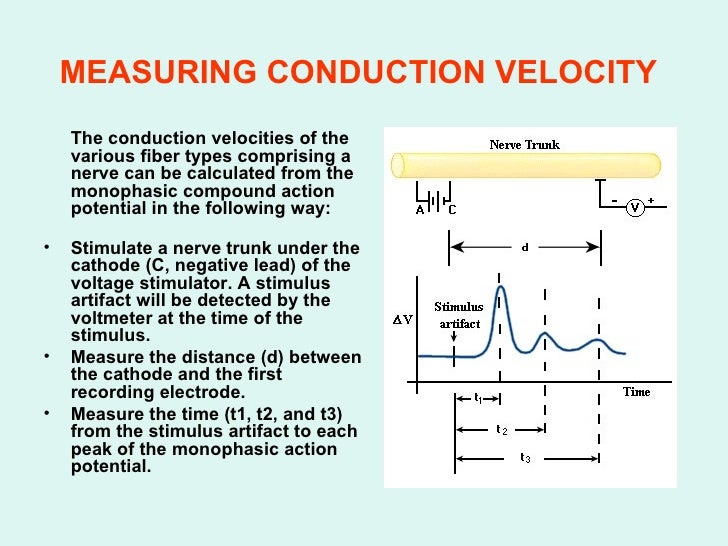Which Of The Following Would Have The Fastest Conduction Speed

The human nervous system, a complex network responsible for everything from reflexes to conscious thought, relies on electrical signals transmitted along neurons. But not all neurons are created equal. The speed at which these signals travel, or the conduction velocity, varies dramatically, influencing the efficiency and responsiveness of our bodies.
At the heart of this question lies the intricate interplay of neuronal structure and physiological properties. Myelination, axon diameter, and temperature are all critical factors influencing the speed of neural transmission. Understanding these factors is not just an academic exercise; it has profound implications for understanding neurological diseases and developing effective treatments.
Myelination: The Insulation Advantage
Perhaps the most significant factor affecting conduction velocity is myelination. Myelin is a fatty substance that insulates the axon, the long, slender projection of a neuron that conducts electrical impulses.
This insulation is not continuous, but rather interrupted at intervals called Nodes of Ranvier. These gaps allow for a process called saltatory conduction, where the electrical signal "jumps" from one node to the next, significantly increasing the speed of transmission.
Myelinated axons can conduct signals much faster than unmyelinated axons, sometimes by a factor of 50 or more, according to research published in the Journal of Neuroscience.
Axon Diameter: Bigger is Better
The diameter of the axon also plays a crucial role in conduction velocity. A wider axon offers less resistance to the flow of ions, the charged particles that carry the electrical signal.
Think of it like a pipe carrying water; a wider pipe allows for a greater volume of water to flow through it more easily. Similarly, a larger axon diameter reduces the internal resistance, allowing the electrical signal to propagate faster.
Studies have consistently demonstrated a positive correlation between axon diameter and conduction velocity, as reported in numerous neuroscience textbooks and peer-reviewed articles.
Temperature: A Less Obvious Influencer
While less frequently discussed, temperature also affects conduction velocity. Higher temperatures generally increase the speed of nerve impulse transmission, within physiological limits.
This is because higher temperatures increase the kinetic energy of the ions involved in the electrical signal. The effects of hypothermia on nerve function are well-documented. It leads to slower conduction and impaired neural function.
Extreme temperatures can damage the nerve, but within a normal range, temperature influences the rate of ion channel opening and closing, thereby affecting conduction speed.
Putting it All Together: Comparing Neurons
Considering these factors, we can confidently say that a myelinated axon with a large diameter will have the fastest conduction speed. This type of neuron is typically found in motor neurons, which need to transmit signals quickly to muscles to initiate rapid movements.
In contrast, unmyelinated axons with smaller diameters have slower conduction speeds. These neurons are often involved in sensory pathways where speed is less critical.
Sensory neurons that detect pain, for example, often have relatively slow conduction velocities.
Clinical Significance: Diseases Affecting Conduction Velocity
Understanding the factors that influence conduction velocity is crucial for diagnosing and treating neurological disorders. Diseases like multiple sclerosis (MS), for example, involve the demyelination of nerve fibers.
This demyelination disrupts the process of saltatory conduction, leading to significantly slower nerve impulse transmission and a range of neurological symptoms. Nerve conduction studies, where the speed of nerve impulses is measured, are essential tools for diagnosing MS and other demyelinating diseases.
Similarly, conditions that affect axon diameter, such as certain types of neuropathy, can also impair conduction velocity and lead to neurological dysfunction. Early diagnosis and intervention can sometimes mitigate the effects of these diseases.
Future Directions: Enhancing Conduction Velocity
Researchers are actively exploring ways to enhance conduction velocity in damaged or diseased nerves. One promising area of research involves promoting remyelination in demyelinated axons.
Scientists are also investigating the potential of gene therapy to increase axon diameter and improve nerve function. The development of drugs that can enhance ion channel function is another area of active research.
The goal of these efforts is to restore or improve nerve function in patients with neurological disorders, ultimately improving their quality of life.
Conclusion: A Key to Understanding the Nervous System
Conduction velocity is a fundamental property of neurons that influences the speed and efficiency of neural communication. Myelination and axon diameter are the primary determinants of conduction speed, with temperature also playing a role.
Understanding these factors is essential for comprehending the complexities of the nervous system. It’s also crucial for developing effective treatments for neurological diseases that affect conduction velocity.
Further research in this area promises to yield new insights into the workings of the brain and nervous system. It might provide innovative therapies for a wide range of neurological disorders.


















